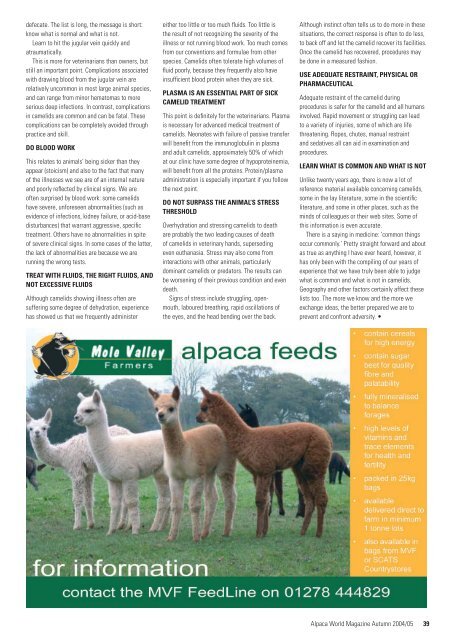You also want an ePaper? Increase the reach of your titles
YUMPU automatically turns print PDFs into web optimized ePapers that Google loves.
defecate. The list is long, the message is short:<br />
know what is normal and what is not.<br />
Learn to hit the jugular vein quickly and<br />
atraumatically.<br />
This is more for veterinarians than owners, but<br />
still an important point. Complications associated<br />
with drawing blood from the jugular vein are<br />
relatively uncommon in most large animal species,<br />
and can range from minor hematomas to more<br />
serious deep infections. In contrast, complications<br />
in camelids are common and can be fatal. These<br />
complications can be completely avoided through<br />
practice and skill.<br />
DO BLOOD WORK<br />
This relates to animals’ being sicker than they<br />
appear (stoicism) and also to the fact that many<br />
of the illnesses we see are of an internal nature<br />
and poorly refl ected by clinical signs. We are<br />
often surprised by blood work: some camelids<br />
have severe, unforeseen abnormalities (such as<br />
evidence of infections, kidney failure, or acid-base<br />
disturbances) that warrant aggressive, specifi c<br />
treatment. Others have no abnormalities in spite<br />
of severe clinical signs. In some cases of the latter,<br />
the lack of abnormalities are because we are<br />
running the wrong tests.<br />
TREAT WITH FLUIDS, THE RIGHT FLUIDS, AND<br />
NOT EXCESSIVE FLUIDS<br />
Although camelids showing illness often are<br />
suffering some degree of dehydration, experience<br />
has showed us that we frequently administer<br />
either too little or too much fl uids. Too little is<br />
the result of not recognizing the severity of the<br />
illness or not running blood work. Too much comes<br />
from our conventions and formulae from other<br />
species. Camelids often tolerate high volumes of<br />
fl uid poorly, because they frequently also have<br />
insuffi cient blood protein when they are sick.<br />
PLASMA IS AN ESSENTIAL PART OF SICK<br />
CAMELID TREATMENT<br />
This point is defi nitely for the veterinarians. Plasma<br />
is necessary for advanced medical treatment of<br />
camelids. Neonates with failure of passive transfer<br />
will benefi t from the immunoglobulin in plasma<br />
and adult camelids, approximately 50% of which<br />
at our clinic have some degree of hypoproteinemia,<br />
will benefi t from all the proteins. Protein/plasma<br />
administration is especially important if you follow<br />
the next point.<br />
DO NOT SURPASS THE ANIMAL’S STRESS<br />
THRESHOLD<br />
Overhydration and stressing camelids to death<br />
are probably the two leading causes of death<br />
of camelids in veterinary hands, superseding<br />
even euthanasia. Stress may also come from<br />
interactions with other animals, particularly<br />
dominant camelids or predators. The results can<br />
be worsening of their previous condition and even<br />
death.<br />
Signs of stress include struggling, openmouth,<br />
laboured breathing, rapid oscillations of<br />
the eyes, and the head bending over the back.<br />
Although instinct often tells us to do more in these<br />
situations, the correct response is often to do less,<br />
to back off and let the camelid recover its facilities.<br />
Once the camelid has recovered, procedures may<br />
be done in a measured fashion.<br />
USE ADEQUATE RESTRAINT, PHYSICAL OR<br />
PHARMACEUTICAL<br />
Adequate restraint of the camelid during<br />
procedures is safer for the camelid and all humans<br />
involved. Rapid movement or struggling can lead<br />
to a variety of injuries, some of which are life<br />
threatening. Ropes, chutes, manual restraint<br />
and sedatives all can aid in examination and<br />
procedures.<br />
LEARN WHAT IS COMMON AND WHAT IS NOT<br />
Unlike twenty years ago, there is now a lot of<br />
reference material available concerning camelids,<br />
some in the lay literature, some in the scientifi c<br />
literature, and some in other places, such as the<br />
minds of colleagues or their web sites. Some of<br />
this information is even accurate.<br />
There is a saying in medicine: ‘common things<br />
occur commonly.’ Pretty straight forward and about<br />
as true as anything I have ever heard, however, it<br />
has only been with the compiling of our years of<br />
experience that we have truly been able to judge<br />
what is common and what is not in camelids.<br />
Geography and other factors certainly affect these<br />
lists too. The more we know and the more we<br />
exchange ideas, the better prepared we are to<br />
prevent and confront adversity.<br />
Alpaca World Magazine Autumn 2004/05 39







